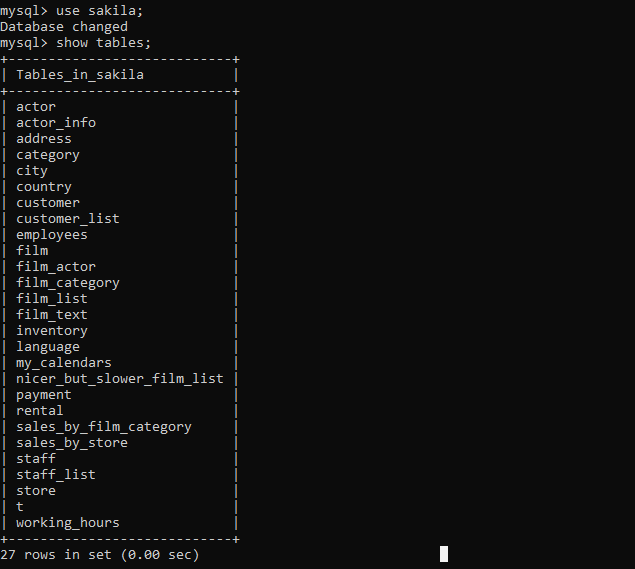

- #Sakila database mysql download password
- #Sakila database mysql download download
- #Sakila database mysql download mac
- #Sakila database mysql download windows
#Sakila database mysql download password
The password you just assigned the new user will go within the single-quote marks (and, yes, MySQL’s internal syntax isn’t always consistent): The final step is to grant all privileges on your new database to the testuser by the following command. SET PASSWORD FOR newdatabaseuser= PASSWORD(“1234”) For instance, if you were to choose 1234 as your password (an extraordinarily bad idea, incidentally), the command would look like this: Note that your password will actually go within the quotation marks, and that the password is case-sensitive. Just as with the root user, you’ll want to choose a strong password. SET PASSWORD FOR newdatabaseuser= PASSWORD(“password”) (Note that all commands in MySQL must end with a semicolon to denote the end of the SQL statement.)Ĭreate a user who can access the database: Once logged into the MySQL command line client, you will create a database, a user for that database, and grant all permissions on that database to that user. Once this command finishes, you’ll need to log into the MySQL command-line client as the root user:Įnter your MySQL root password.

Then run the mysql_secure_installation script to tighten the MySQL server’s security a bit. You’ll then need to activate MySQL with the following command: Shortly thereafter, the installer will finish. For obvious security reasons, you’ll want to create an extremely strong password (a mixture of uppercase, lowercase, numbers, and punctuation, the longer the better) for your MySQL root user. Just like the root user in Linux, the root user in MySQL has absolute control over all databases, tables, permissions, and users. Not far into the installation process, you’ll be asked to provide a root password for MySQL.
#Sakila database mysql download download
It’s a big set of files, so the download might take a bit. Follow the default prompts, and apt-get will download and begin installing MySQL. To begin, make your way to a Terminal window, and type the following command to download the MySQL server files and begin installation (always remember that commands are case-sensitive):

Then I refreshed my phpmyadmin screen and lo and behold, there was sakila.MySQL is one of the most popular open-source database servers, and it’s quite simple to do a basic installation and setup on Ubuntu 10.10 Maverick Meerkat.Deleted the end space, added a semi-colon, hit enter. Then I repeated with SOURCE and dragged the data.sql file into Terminal.Then I typed SOURCE (with a space at the end) and dragged the schema.sql file into Terminal, deleted a space at the end of the file path, put a semi colon there, and hit enter. It was clear once I'd logged in: I got a Welcome message.Before I got the right syntax, Terminal app kept telling me "mysql: command not found".
#Sakila database mysql download windows
Some instructions for Linux and Windows are here: Depending on your operating system and your server, your username / password might be presented differently too. If you aren't using MAMP, your path would be different - it involves finding the MySQL folder on your C drive (PC) or within Applications (mac). Based on SreerajS's answer on a forum, I ran this: /Applications/MAMP/Library/bin/mysql -host=localhost -uroot -proot ( ).I don't think you need to do this step but I include it for completeness. I installed MySQL Workbench application.I started both MySQL and Apache servers running in MAMP.

#Sakila database mysql download mac
#Another method, via terminal app, on a mac So I gave up and followed the instructions via the command line, which strikes me as needlessly difficult for beginners. Some suggestions are online that you can't import via phpmyadmin if the file size exceeds 2MB. Even when I remove the commented out lines (whose purpose is to create spatial / geometric fields for MySQL versions 5.7.5+), I still get an error, which tells me the address table cannot be created. I get an error about geometry (which is due to a commented out line in the SQL). I also had to temporarily change MySQL's maximum import size (using a line of SQL I found online): When I imported the files, I had to untick the box that said "Allow the interruption of an import in case the script detects.". A nice-to-have, but not critical in creating a database. mwb file, which is only useful if you have MySQL Workbench installed, at which point it supplies you a database diagram. I imported the schema file and then the data file, ignoring the. sql files delete and re-create the database anyway. I did not create a database called Sakila and then populate it: the. The first time I downloaded the sakila database, I did it via phpmyadmin using Import at the Server level.


 0 kommentar(er)
0 kommentar(er)
